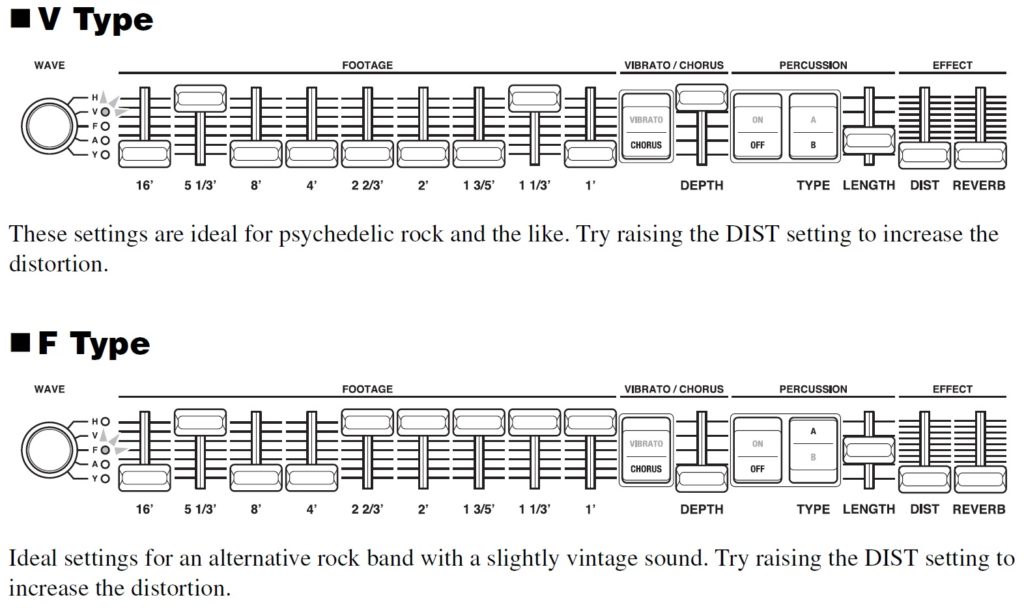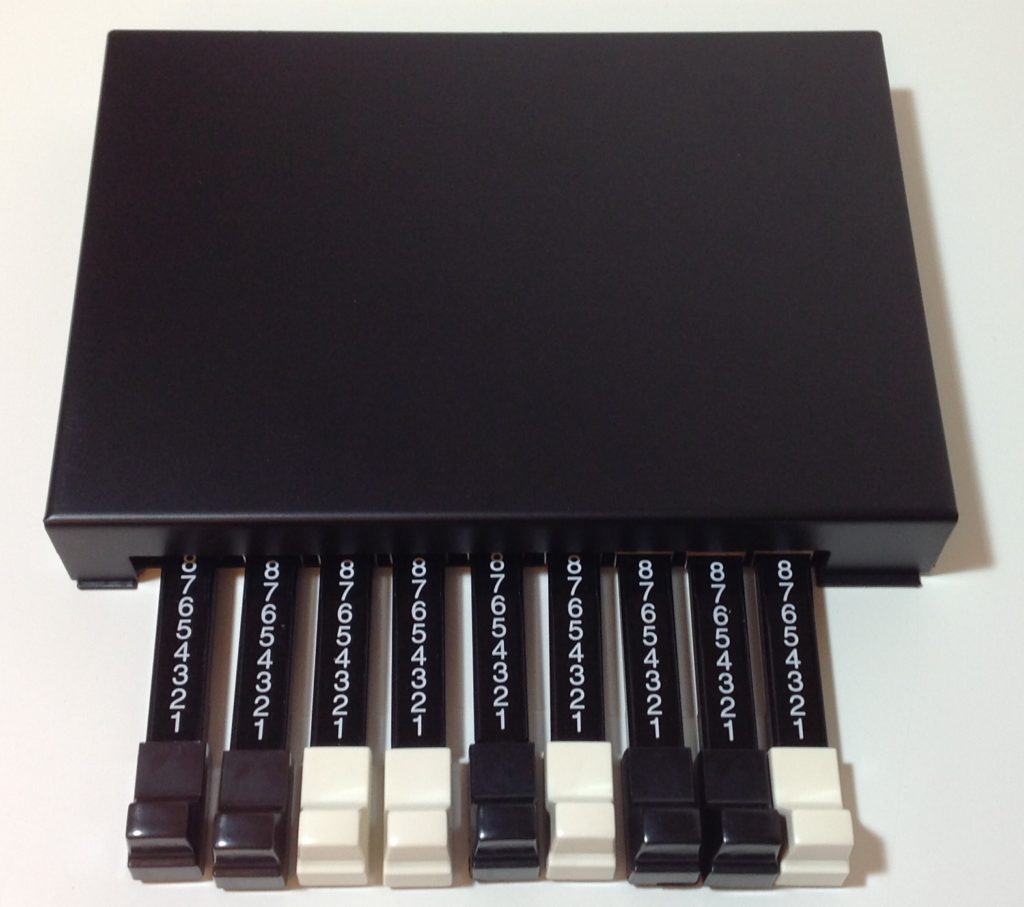Checking out organ-related threads in the music forums, combo organs get short shrift while most folks focus on the Hammond B-3 tonewheel sounds. Today’s post will (almost) ignore the B-3…
Organ-focused keyboards from Nord, Hammond, Yamaha and others have combo organ emulations in addition to tonewheel synthesis. All offer two vintage flavors: Vox and Farfisa. Nord and Hammond throw in pipe organ, piano, EP and instrument emulations, too, making for full all-rounders.
Drawbar control abounds! In the case of Vox, each physical Nord drawbar corresponds to a Vox Continental drawbar footage (with possible extensions). Nord Electro 6, for example, offers 16′, 8′, 4′, 2′, II, III, IV and sine. The 16′, 8′, 4′, IV and sine are basic Continental tones. Nord’s emulation kicks the basics up to dual-manual, Continental II territory by adding a 2′ footage and two overtone mixtures, II and III. The mixtures consist of the following ranks:
- II: 5 1/3′ and 1 3/5′ pipes
- III: 2 2/3′, 2′ and 1′ pipes
- IV: 2 2/3′, 2′, 1 3/5′ and 1′ pipes
The III and IV mixtures add the Hammond-like overtones missing from the original Continental. Hammond employ a similar Vox drawbar assignment in the Sk1/Sk2 series.
Discrete voice (tab) stops pose a minor problem: How to provide discrete On/Off control with sliders (drawbars)? In the case of Farfisa emulation, Nord and Hammond assign each Farfisa tab to a drawbar:
Drawbar Farfisa (Nord) Farfisa (Hammond)
------- -------------- -----------------
1 Bass 16' Bass 16'
2 Strings 16' Strings 16'
3 Flute 8' Flute 8'
4 Oboe 8' Oboe 8'
5 Trumpet 8' Trumpet 8'
6 Strings 8' Strings 8'
7 Flute 4' Flute 4'
8 Strings 4' Piccolo 4'
9 2 2/3 Strings 4'
The Hammond voice set is the same as the Farfisa Combo Compact. The Combo Compact Deluxe replaced the Piccolo 4′ voice with a bright 2 2/3′ overtone tab, adding a bit of Hammond-like whistle. The Nord voice set covers the Combo Compact Deluxe model.
Yamaha have taken their own approach to combo organ emulation with the YC61. The YC61 synthesizes tonewheel tones through Virtual Circuit Modeling (VCM) that emulates the sound of analog tonewheels and associated circuitry. Vox (YC61 organ model F2) and Farfisa (model F3) sounds are produced using frequency modulation (FM) synthesis. The YC61 also provides a sine wave “combo” model (F1). The YC61 drawbars bring in the usual drawbar footages with the exception of the 1′ drawbar which is disabled in all FM models (F1, F2, and F3).
Gotta wonder if we can port the F1, F2 and F3 FM organs to Montage and MODX?
Thanks to the frapping pandemic, I have yet to play a YC61. (Grrr.) However, I have played the Nord Electro 6D and Hammond Sk1. Both provide excellent combo organ sounds. Pipe organ (Nord and Hammond) is a big plus for a church player. I give Nord’s orchestral samples and library the edge over Hammond.
Yamaha Reface YC
Yamaha Reface YC promises tonewheel and combo organ sounds on the cheap. By and large, it delivers. I have really worked the Reface YC as a rehearsal instrument and as a gig instrument in church. That said, here are some detailed observations (positive and negative).

I roll my eyes a bit whenever anyone posts about how they “wish the Motif XF (Montage, MODX) had the Reface YC technology inside.” News flash, the Reface YC shares much of its technology with Motif XF, Montage and MODX already. Yamaha simply repackaged and revoiced the basic AWM2 DNA in a wonderfully accessible form. Wisely, Yamaha reacted to the warm user reception and reaction caused by the YC and its popular pal, the Reface CP. Yamaha is now taking it to the bank with the current full-sized CP and YC keyboards.
The Reface YC emulates five different organ models:
- H: Hammond tonewheel
- V: Vox transistor organ (1960s)
- F: Farfisa transistor organ (1960s)
- A: Acetone transistor organ (1970s)
- Y: Yamaha transistor organ (1972)
The Reface YC drawbars, buttons and sliders directly map to Hammond organ drawbars and controls. What about the combo organs?
I stripped away all of the effects (percussion, chorus, distortion, reverb, etc.) and sampled each of the five voices (8′ foot pipe, middle C). The five waveforms are pictured below. The H and V waves, especially, have a sinusoidal shape. The nasal F wave is truly unique. [Click image to enlarge.]

Since the Vox Continental had drawbars itself, the YC drawbars correspond to a single Vox drawbar sound (the V wave) played back at the appropriate footage (pitch). The YC Vox is based on a single Vox wave, just like the Montage (MODX and Motif XF). In Montage land, this is the “Vx Drawbar1-3” waveform. In the “you get want you pay for” department, the YC Vox does not have the reed and sine drawbars/sounds, and you must dial in the II, III, and IV mixtures yourself.
For the sake of authenticity, one should never put a combo organ through the rotary speaker effect. Trust me. Most of us in the 60s could barely afford an organ and an amp, let alone buy a Leslie. Then there is the issue of getting to the gig. Everything needed to fit into the back of Dad’s car!
The YC Farfisa, Acetone and Yamaha organ implementations follow the same design as the Vox. Each of the four combo organs (V, F, A and Y) consist of a single wave played back at different pitches according to drawbar footage.
Listening to the stripped down F wave, my first thought was “Accordion!” The 60s Farfisa organs were designed by accordion makers and I believe that the raspy Farfisa tone is their intentional attempt to build an electronic accordion. [Memories of Mom and Dad saying, “Why don’t you play accordion and learn a few wedding songs?” Who knew?] The name “Farfisa” is a contraction of “Fabbriche Riunite De Fisarmoniche”, the company formed by pre=World War 2 Italian accordian makers Settimio, Soprani, Scandalli, and Frontallini. It ain’t an accident, folks.
Thus, in terms of control, the Reface YC is quite unlike a real Farfisa Combo Compact with its discrete voice tabs. Once again, you pay more for Nord or Hammond and you get more authenticity. That doesn’t mean you can’t get a decent Farfisa tone out of Reface YC. It’s raspy enough for Wooly Bully and other cover songs. The chosen F wave is versatile and, well, Farfisa voices are pretty much the same wave filtered differently. The screaming Tone Boost is missing in action, though.
I give the Reface YC an A- and B+, respectively, for Vox and Farfisa authenticity. I don’t have any direct experience with Acetone and early Yamaha organs — just the soundtracks of old Japanese kaiju (monster) movies. The YC sounds realistic enough.
I experimented with YC percussion in isolation, too. Each of the Reface combo organ voices has its own distinctive percussion. I recommend trying this at home as some of the settings are almost clav-like and would do in a pinch. A few settings remind me of the 1970s Crumar Roadrunner electronic piano — the most crap-tastic electronic piano ever made. Yes, I owned one, played one, and sold it off as fast as humanly possible. 🙂
After analyzing the Reface YC, I understand better how Yamaha teased organ voices from modest hardware. I also have renewed respect for the Montage (MODX, Motif XF) organ voicing and real-time control. The Montage, MODX and Motif XF have all the sonic materials necessary to meet and/or best the Reface YC. Still, you can’t throw a Montage or a MODX into a tiny bag and jump on the bus, train or plane.
DIY drawbar control
If you want to add a few drawbars via MIDI, try my Sparfun Danger Shield drawbars project. Or, at least read my Sparkfun Danger Shield review.

I also gave the Crumar D9U drawbar kit a spin:
- Crumar D9U in the house
- Crumar D9U: Day one
- Curmar D9U: Assembly and initial test code
- Crumar D9U: Troubleshooting
- Crumar D9U: Testing MIDI
- Crumar D9U: Nord Electro 2 Sketch
The Crumar D9U is a DIY, Arduino-compatible drawbar kit. This series of articles describe my experience from beginning to end and include C code. Don’t want DIY? Then try the ready-made Crumar D9X.
Copyright © 2021 Paul J. Drongowski
